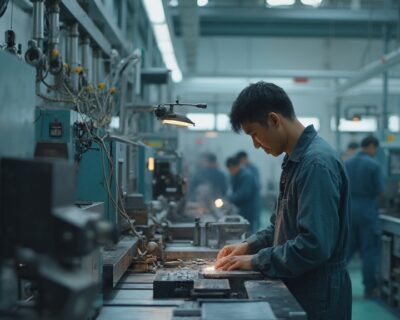Blogs

Understanding the Specifications of AMS 5536 Stainless Steel
Introduction
The aerospace industry demands materials that can withstand extreme conditions, ensuring reliability and performance in critical applications. AMS 5536, a high-performance stainless steel alloy, embodies these requirements by offering exceptional corrosion resistance, high strength, and durability at elevated temperatures. This nickel-chromium-molybdenum alloy is not only pivotal in aerospace applications but also finds significant usage in marine, automotive, and chemical processing industries.
The intricate balance of its chemical composition, coupled with its impressive physical properties, makes AMS 5536 an indispensable material for environments where both resilience and longevity are paramount. This article delves into the specifics of AMS 5536, exploring its chemical makeup, physical attributes, applications, and the stringent standards it adheres to, providing a comprehensive understanding of why this alloy is a preferred choice for various high-stress industries.
What is AMS 5536?
AMS 5536 outlines the standards for a high-performance stainless steel alloy essential in aerospace applications. This specification pertains to a nickel-chromium-molybdenum alloy, famous for its remarkable protection against corrosion, high strength, and capacity to withstand extreme temperatures. The significance of corrosion resistance cannot be overstated, particularly in marine applications. As research has indicated, even the most mechanically strong substances can have limited utility if they are vulnerable to seawater corrosion. Progress in comprehending corrosion mechanisms has opened avenues for improved substances and production methods, guaranteeing that stainless steel elements continue to be robust and strong in extreme environments. For instance, the development of new stainless steel for green hydrogen production from seawater highlights the substance’s versatility and cost-effectiveness compared to traditional titanium structures. This breakthrough not only benefits the aerospace industry but also extends to other sectors requiring robust, corrosion-resistant materials.
Chemical Composition of AMS 5536
The chemical composition of AMS 5536 is meticulously designed to include a balanced blend of nickel, chromium, molybdenum, and other trace elements, each contributing unique properties to the alloy. Nickel, an essential element, greatly improves toughness and offers excellent protection against corrosion, rendering it crucial for uses in challenging settings like offshore wind turbines and nuclear power facilities. Chromium enhances the substance’s oxidation resistance, ensuring durability in high-temperature conditions often encountered in fossil fuel power stations and LNG facilities. Molybdenum, another crucial element, bolsters the overall strength and stability of the alloy, particularly in high-temperature environments, where it is essential for maintaining performance and integrity. This strategic combination of elements makes AMS a robust choice for industries requiring materials that can withstand extreme conditions while maintaining structural integrity and performance.

Physical Properties of AMS 5536
AMS demonstrates an exceptional combination of mechanical and physical properties, making it highly suitable for rigorous applications. With a tensile strength that withstands substantial stress without deformation, it excels in high-stress environments. Additionally, AMS maintains its structural integrity even at elevated temperatures, crucial for applications involving thermal cycling. Its density and thermal expansion coefficients further enhance its performance, particularly in high-temperature settings. The alloy’s low thermal expansion coefficient and high thermal conductivity, comparable to advanced alloys like type 304 stainless steel, underscore its versatility in demanding conditions. Such characteristics make AMS an optimal option for sectors that demand substances to withstand extreme conditions, such as aerospace and nuclear energy.

Applications of AMS 5536
AMS is a crucial substance in the aerospace, automotive, and chemical processing sectors because of its outstanding strength and resistance to corrosive surroundings. Its application is crucial in the manufacturing of gas turbine components, fasteners, and parts subjected to high temperatures and aggressive chemicals, ensuring reliability and longevity in demanding conditions. The specification of AMS guarantees that substances meet the rigorous standards required by these industries, supporting the production of highly efficient and durable components. For instance, the aerospace sector, facing a recovery surge post-COVID-19, relies heavily on such advanced materials to maintain high production rates and replace retiring experts with new talent, ensuring the transfer of specialized domain knowledge. The automotive industry benefits from AMS’s properties by enabling the production of safer, more fuel-efficient vehicles, while the chemical processing sector leverages its resistance to harsh chemicals, enhancing operational safety and efficiency.

Specifications and Standards for AMS 5536
AMS 5536 is meticulously crafted to adhere to rigorous industry standards, ensuring both quality and reliability. This specification mandates that substances meet precise mechanical and chemical requirements, critical for guaranteeing optimal performance and compliance with safety regulations. This is particularly vital for manufacturers operating in highly regulated sectors such as aerospace, automotive, and defense, where adherence to stringent standards is not just a preference but a necessity. These industries rely on materials that offer exceptional tensile strength, corrosion resistance, and fatigue life to meet their unique reliability standards. As a result, AMS becomes an essential option, guaranteeing that end products not only operate effectively but also satisfy the most stringent safety and regulatory standards.

Fabrication and Welding Characteristics of AMS 5536
The fabrication and welding of AMS require careful consideration because of its distinctive alloying components. This substance can be shaped using standard techniques such as forging, machining, and welding. Nevertheless, when welding AMS 5536, it is crucial to employ appropriate filler materials and methods to prevent problems such as cracking or a decrease in corrosion resistance. For instance, higher quality filler metals, though initially more expensive, can significantly enhance weld quality and reduce the need for rework, ultimately benefiting the entire production cycle. Post-weld heat treatment is often necessary to restore the alloy’s properties, ensuring the integrity and durability of the weld. The mechanical properties and microstructural characteristics of the weldments, studied through uniaxial tensile tests and scanning electron microscopy, provide insights into the effects of various welding parameters such as temperature, workpiece thickness, and the welding environment. This comprehensive approach ensures the suitability and reliability of welding methods for AMS 5536, making it a robust choice for demanding applications.

Conclusion
The analysis of AMS 5536 clearly highlights its critical role as a high-performance stainless steel alloy across various demanding industries. With its exceptional corrosion resistance, high strength, and durability at elevated temperatures, AMS 5536 stands out as an indispensable material for applications in aerospace, automotive, and chemical processing. The alloy’s unique chemical composition, featuring a strategic blend of nickel, chromium, and molybdenum, ensures enhanced toughness and resilience, essential for environments subjected to extreme conditions.
Furthermore, the physical properties of AMS 5536, including its tensile strength and low thermal expansion coefficient, make it particularly suited for high-stress applications. Its ability to maintain structural integrity under thermal cycling and aggressive chemical exposure reinforces its value in sectors that prioritize reliability and safety. The rigorous specifications and standards associated with AMS 5536 underscore its compliance with industry demands, ensuring that manufacturers can trust in the performance and longevity of their components.
In conclusion, AMS 5536 represents a strategic choice for procurement managers seeking materials that can meet the challenges of modern engineering. Its versatility, combined with its adherence to stringent quality standards, positions AMS 5536 as a cornerstone of innovation in high-performance applications. As industries continue to evolve, the importance of selecting materials like AMS 5536 that offer both resilience and efficiency cannot be overstated, paving the way for advancements across multiple sectors.




